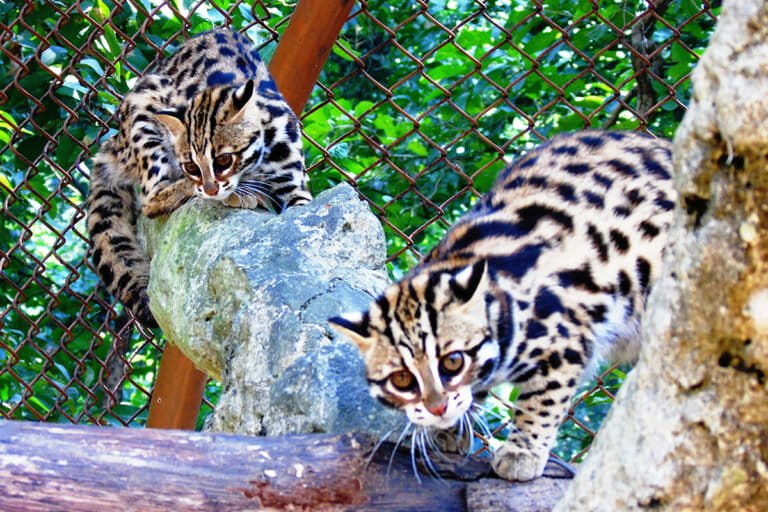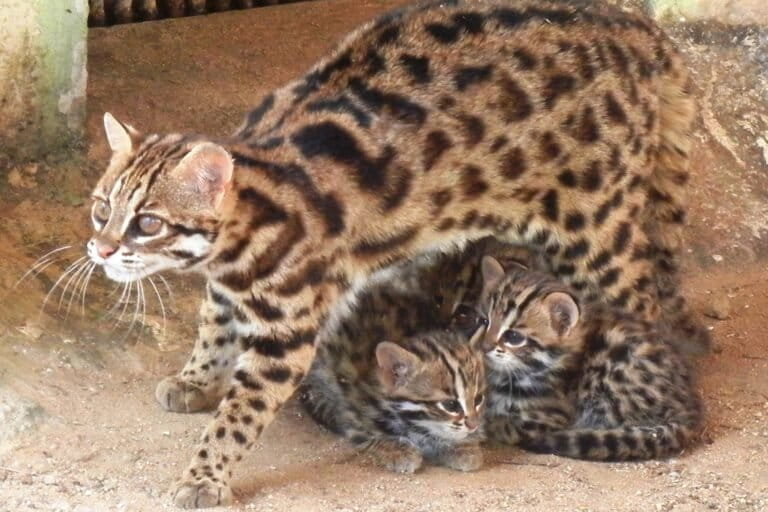- In this interview, Ajay Kumar, an expert in animal breeding and genetics, shares his experience and insights into ex-situ conservation, especially captive breeding of leopard cats.
- According to Kumar, shelter and food are two important factors for leopard cats to ensure they are in a stress-free environment to facilitate successful reproduction.
- Kumar highlighted the need for more zookeepers with a certain level of expertise in India. He stressed upon caretakers’ pivotal role and interest in captive breeding and species conservation.
Ajay Kumar, an accomplished animal breeding and genetics professional, formerly served as the Veterinary Officer at Bhagwan Birsa Biological Park in Ranchi, the capital of Jharkhand.
During his tenure at Birsa Zoo, Kumar carried out the successful breeding of leopard cats (Prionailurus bengalensis) on three separate occasions. The leopard cat is a small wildcat species and while it is widely distributed and can survive a variety of habitats, it is exposed to multiple threats that small cats face in India, such as road accidents, snaring, hunting, pesticides in crop fields and climate change.
Presently, Kumar holds the position of Veterinary Officer in Bokaro district of Jharkhand. In a conversation with Mongabay-India, he shared his experience and insights into the breeding of small cats.

Mongabay: How crucial is captive breeding for wildlife and how does it impact the species’ wild populations? How feasible is captive breeding without endangering existing populations?
Ajay Kumar: Captive breeding involves reproduction of wild animals in a controlled environment. When wild cats, whose natural habitat is in forests, are relocated from these habitats to places like zoos, they are considered to be in captivity.
The primary aim of captive breeding is to observe and understand the behaviour of endangered species. Based on this understanding, efforts are concentrated on the conservation of these species. Captive breeding serves two primary purposes: maintaining the population numbers of a species and reintroducing individuals into their native forest habitats. Such species often face declining populations or inbreeding because of low population density, wherein closely related individuals interbreed. To address inbreeding, altering the male’s territory becomes necessary.
Mongabay: What is the natural diet of the leopard cat and how does it differ in captivity? How does this impact its breeding pattern?
Ajay Kumar: Reproduction in any species is influenced by two critical aspects: its habitat and its food. The suitability of the living environment profoundly affects breeding. Providing the preferred habitat, horizontal or vertical space and offering suitable prey, play crucial roles.
Vitamins A and E are essential for reproductive behaviour and their diet includes natural sources of these vitamins. Food such as bird meat, poultry and specific meats are provided to simulate hunting and maintain dental health. Creating a microclimate akin to their natural habitat is also crucial.

Mongabay: How do frequent zoo visits and observations by the public affect wild animals?
Ajay Kumar: Continuous public observation in zoos causes stress to animals. To mitigate this, breeding pairs are kept away from visitor areas to allow for a more natural and stress-free environment. Ensuring good health conditions leads to successful breeding.
We had brought a leopard cat from Assam State Zoo, Guwahati, to Birsa Zoo, Ranchi, in March 2012. During the quarantine period, it was bred and successfully had cubs. The gestation period of a leopard cat is very short, 70 days. Two cubs were born in June 2012, one male, and one female. Then, breeding took place in 2014 and 2015. I was in Birsa Zoo till August 2020.
Mongabay: Why did the breeding of leopard cats cease in Birsa Zoo later on?
Ajay Kumar: Close monitoring is essential in this context. The selection of breeding pairs is crucial, considering the compatibility between males and females. Moreover, it’s imperative to ensure that all progeny originate solely from this group, meaning they are closely related. To maintain genetic diversity, the introduction of males from outside is necessary to advance this process.
The leopard cat, categorised as a Schedule II animal under the Wildlife Protection Act, often lacks attention due to its non-charismatic nature. To promote its breeding and conservation, it’s vital to facilitate its breeding across various zoos in the country, enabling a viable exchange program.
Mongabay: How can a healthy captive leopard cat population be maintained, especially concerning genetic diversity and health?
Ajay Kumar: In the scientific approach to managing captive animals, it’s recommended not to disturb the resident male. Instead, the focus should be on facilitating the exchange of its offspring among different zoos. For instance, if the animal is in eastern India, its progeny could be sent to zoos in northeast India or other regions while also introducing males from distant locations. Maximising genetic diversity involves ensuring that the animals are not even remotely related by blood.
In scientific breeding practices, males are sometimes brought in on breeding loans. This process involves temporarily borrowing males from other zoos for a specific duration, usually five or six months, solely for breeding purposes. Once the breeding objectives are achieved, the male is returned. This strategy helps mitigate the risk of inbreeding within a zoo’s population by introducing new genetic diversity from external sources.
Mongabay: Does captivity impact their genetic diversity?
Ajay Kumar: Captivity itself doesn’t significantly affect genetic diversity. Controlled breeding is essential to maintain genetic diversity. Pairing specific individuals for reproduction helps preserve genetic diversity.
Mongabay: What are the challenges in captive breeding of leopard cats?
Ajay Kumar: One of the primary challenges in breeding any cat species is the limited available information on their behaviour. In such cases, the initial step involves an in-depth study of their behaviour and natural inclinations to understand their preferences. Providing an environment or elements that align with their preferences is crucial.
An additional challenge arises when the mother cat displays a tendency to reject her offspring. Some mother cats exhibit low maternal instincts, even going as far as rejecting their babies after birth. This situation deprives the newborns of the essential care they require from their mothers. Fortunately, at Birsa Zoo, the cats exhibited exceptional care for their young.

Furthermore, a significant challenge lies in the necessity for dedicated caretakers. In some zoos, the veterinarians and directors may have multiple responsibilities and cannot dedicate full time to this care. Hence, deploying a team of three individuals working in shifts becomes essential to ensure continuous care. This arrangement guarantees that there’s always someone available for immediate attention and care. Having dedicated and focused personnel becomes a necessity in such situations.
Mongabay: What lessons from your project can be applied to conserve other endangered species facing similar challenges?
Ajay Kumar: Understanding the species’ behaviour is fundamental. It’s crucial to tailor the habitat and housing according to the specific behaviours of the species. Merely placing a male and a female together doesn’t guarantee successful breeding. The housing system should cater to their natural inclinations, incorporating elements like hiding places that mimic their natural environment. Ensuring appropriate microclimatic conditions and nutrition is essential for their well-being and breeding success.
Successful breeding demands a dedicated caretaker. In India, the educational standards for keepers are relatively low. Keepers often possess skills acquired through practical experience, resembling labourers or skilled workers, which differs from the situation in other countries.
Mongabay: Captive breeding programs often face challenges in India. What are your thoughts on the practicality of captive breeding?
Ajay Kumar: The selection of species for captive breeding requires establishing a priority. The Central Zoo Authority has outlined specific species prioritised for captive breeding programs. Within these designated species, careful consideration is given to selecting breeding pairs. It’s essential to ensure that the chosen individuals are least related to each other to avoid inbreeding depression in their offspring.
Nonetheless, controlled inbreeding is occasionally utilised as a tool in scientific breeding. This approach becomes necessary, for instance, when developing a pure line of a particular species.
Mongabay: What kinds of small cats are rich in forest resources in eastern India or Jharkhand?
Ajay Kumar: Despite the presence of many jungle cats in Jharkhand, their breeding is not leading to the expected population increase. It’s possible that their predators have multiplied, contributing to this stagnant population growth. Moreover, if breeding occurs, the survival rate of their offspring seems to be low.
I believe it’s crucial for each state to assess its local species and determine their significance within the local fauna. Monitoring their population trends — whether they’re dwindling or growing — becomes an essential part of this evaluation process. Disruption in the population of any species within an ecosystem signifies an imbalance. Each species contributes uniquely to the environment. With this understanding, concerted efforts should be directed toward ensuring the safety and stability of the local species’ populations.
This story was first published in Mongabay Hindi.
Banner image: The leopard cat, categorised as a Schedule II animal under the Wildlife Protection Act, often lacks attention due to its non-charismatic nature. Photo by Ajay Kumar.
